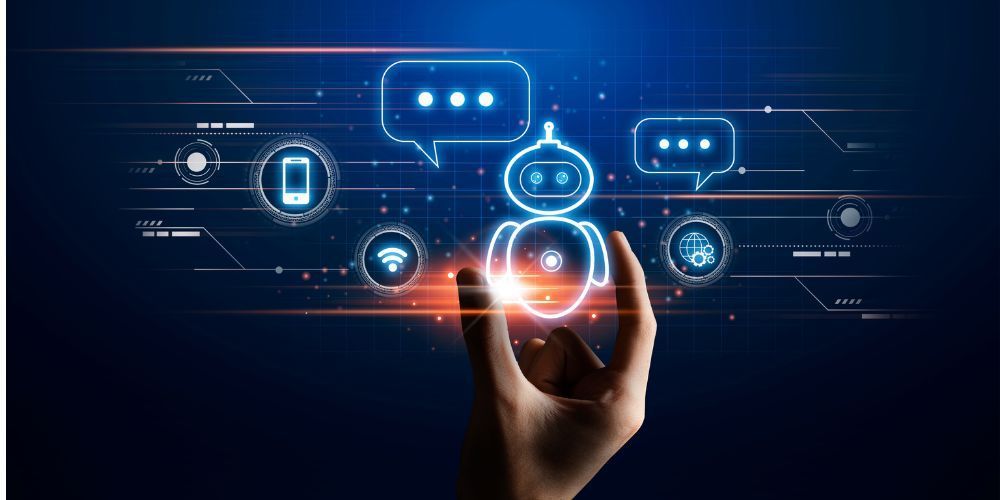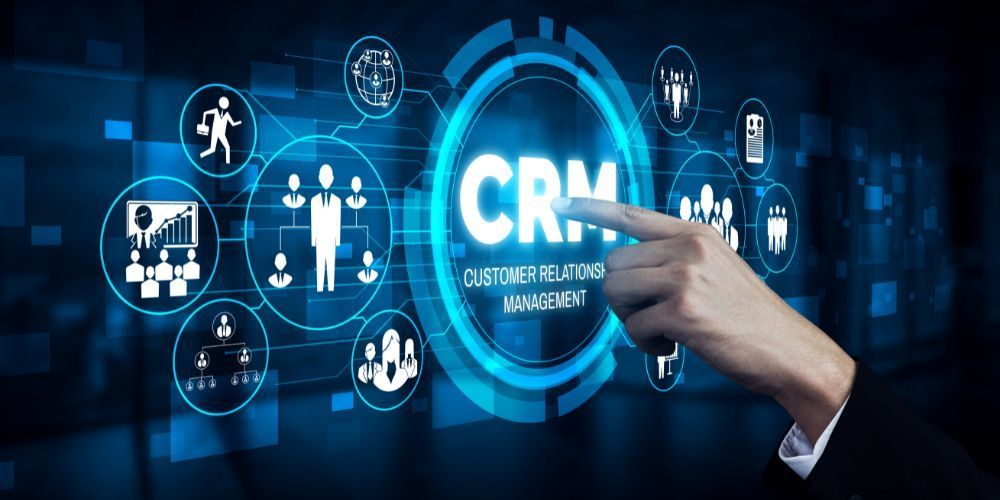Staying Ahead in AI-Driven Marketing: A CMO's Guide
The role of the Chief Marketing Officer (CMO) is evolving at an unprecedented pace, driven by rapid advancements in artificial intelligence (AI). From predictive analytics to hyper-personalized customer journeys, AI is revolutionizing the marketing landscape. CMOs who fail to embrace these changes risk falling behind their competition. This guide offers key strategies to help CMOs adapt and thrive in an AI-driven marketing environment.

Leverage AI for Data-Driven Decision Making
Modern marketing is powered by data, and AI enhances the ability to analyze vast amounts of information in real time. The days of quarterly reporting cycles and delayed insights are over. Today's marketing leaders need immediate, actionable intelligence to remain competitive. AI transforms data from a retrospective asset into a predictive powerhouse, enabling CMOs to anticipate market shifts and consumer behavior changes before they fully materialize. This forward-looking capability creates a distinct competitive advantage that traditional analytics simply cannot match.
Practical Applications
- Implement AI-driven analytics tools to extract actionable insights from customer data, revealing patterns that wouldn't be visible through traditional analysis. These tools can identify micro-segments within your audience, predict customer lifetime value with remarkable accuracy, and detect emerging trends that might otherwise go unnoticed until they become mainstream—at which point the first-mover advantage is lost.
- Use machine learning algorithms to refine audience segmentation and optimize campaign performance through continuous learning. Unlike static segmentation models that require manual updates, AI-powered segmentation evolves in real-time based on behavioral signals, ensuring your targeting remains precise even as customer preferences shift rapidly in response to market forces.
- Leverage AI-powered dashboards for real-time reporting, reducing reliance on gut instinct and outdated reporting models. These intelligent dashboards don't just display data—they highlight anomalies, suggest causal relationships, and offer specific recommendations for optimization, effectively transforming raw data into strategic guidance that marketing teams can act on immediately.
Case Study: Global Financial Services Firm
A global financial services firm I worked with struggled with fragmented MarTech platforms and inconsistent customer data utilization. After implementing an AI-powered analytics solution that consolidated data streams and provided predictive insights, their marketing team identified previously hidden customer segments and behavioral patterns.
Within six months, they achieved a 22% improvement in campaign effectiveness and reduced decision-making time from weeks to days. The key was not just implementing the technology but training teams to trust and act on AI-generated insights rather than relying solely on historical reporting methods.
Actionable Insight
Adopt AI-driven platforms like Google Analytics 4, Adobe Sensei, or Salesforce Einstein to gain deeper insights into customer behavior. Begin with a specific business challenge that would benefit from improved data analysis, rather than attempting to overhaul all analytics simultaneously.
Personalization at Scale
AI allows CMOs to deliver hyper-personalized experiences by analyzing user behaviors, purchase history, and engagement patterns. This level of personalization was previously impossible at scale. What makes AI-driven personalization revolutionary is not just its ability to customize experiences but to do so dynamically across multiple touchpoints simultaneously. The most sophisticated personalization engines now create cohesive experiences that adapt in real-time as customers move between channels, creating a sense of being truly understood rather than simply targeted. This emotional connection drives loyalty far beyond what traditional segmentation can achieve.
Practical Applications
- Use AI-powered recommendation engines to deliver customized content and product suggestions based on individual user profiles. Advanced recommendation systems go beyond "customers who bought X also bought Y" to understand the contextual relevance of recommendations, considering factors like seasonality, time of day, device type, and even weather conditions in the user's location to optimize relevance and conversion probability.
- Implement AI chatbots for 24/7 customer interactions that feel human and responsive while collecting valuable interaction data. Today's sophisticated conversational AI can detect emotional cues in text, adapt its tone accordingly, and even predict what a customer needs before they fully articulate it—reducing friction and creating moments of delight that strengthen brand affinity while simultaneously building a rich dataset for ongoing personalization improvements.
- Leverage natural language processing (NLP) to create personalized email marketing campaigns with higher open and conversion rates through dynamic content generation. Modern NLP systems can analyze which messaging resonates with specific audience segments, then auto-generate variations optimized for different personality types, reading levels, and purchase motivations—all while maintaining your brand voice and testing continuously to improve performance.
Case Study: Healthcare Industry Leader
While leading digital transformation at a global healthcare organization, we implemented an AI-powered personalization engine across their digital properties. The system analyzed healthcare professional behavior across websites and digital touchpoints to deliver tailored content experiences.
The results were dramatic: engagement time increased by 35%, content consumption rose by 42%, and the company saw a significant reduction in customer service inquiries as users were able to find relevant information faster. Most importantly, the system continuously improved as it gathered more interaction data.
Actionable Insight
Start with one high-impact customer journey to implement AI-driven personalization before expanding. For many organizations, email marketing provides an excellent testing ground with relatively low implementation barriers and measurable results.
Automate Media Buying and Campaign Optimization
AI-powered programmatic advertising is transforming media buying, allowing marketers to optimize ad spend in real time while reducing wasted impressions. The true breakthrough here isn't just automation—it's the creation of self-optimizing campaign ecosystems that continuously improve without human intervention. These systems can process thousands of signals simultaneously, making micro-adjustments that collectively drive significant performance improvements. As third-party cookies phase out and privacy regulations tighten, AI's ability to maximize first-party data value and identify contextual targeting opportunities becomes even more critical for maintaining campaign effectiveness.
Practical Applications
- Use AI to analyze customer intent and adjust bidding strategies dynamically across platforms. Advanced intent models can distinguish between research-phase browsing and purchase-ready behavior with remarkable accuracy, automatically increasing bid aggressiveness when conversion likelihood is high and conserving budget when the prospect isn't ready—all happening in milliseconds across millions of potential impression opportunities daily.
- Implement AI tools to predict ad performance and allocate budgets more efficiently between channels. These predictive models incorporate external factors traditional analytics might miss, such as competitive advertising intensity, industry news events, and even social media sentiment, to forecast which channels will deliver optimal performance in upcoming periods and shift investment accordingly before performance patterns change.
- Experiment with AI-generated ad creatives that tailor messaging to different audience segments based on performance data. Leading-edge platforms can now generate dozens of creative variations, test them with minimal audience exposure, identify winning elements, and recombine them into increasingly effective new versions—essentially evolving your creative strategy through principles similar to natural selection but compressed into days rather than generations.
Case Study: Retail Brand Transformation
A mid-sized retail brand I consulted with was struggling with inefficient ad spend across multiple digital channels. By implementing an AI-powered media buying solution, we were able to analyze campaign performance in real-time and automatically shift budget to the highest-performing channels and creatives.
Within three months, their cost per acquisition dropped by 31%, while conversion rates increased by 24%. The marketing team shifted from spending hours manually adjusting campaigns to focusing on strategic initiatives while AI handled tactical optimizations.
Actionable Insight
Begin with a pilot program using platforms like The Trade Desk, Google's Performance Max, or MediaMath to experience AI-enhanced media buying. Set clear KPIs and compare results against your traditional media buying approaches to build internal confidence in AI capabilities.

Enhance Customer Experience with AI-Powered Conversational Marketing
AI-driven chatbots and virtual assistants enhance customer interactions while reducing operational costs, creating a win-win for both customers and organizations. What makes today's conversational AI truly transformative is its ability to create genuine dialogue rather than simply responding to prompts. These systems build context over time, remember previous interactions, understand nuanced questions, and deliver solutions that feel remarkably human. The distinction between automated and human support continues to blur, creating frictionless experiences that satisfy customers' growing expectation for immediate, accurate assistance across every channel and touchpoint.
Practical Applications
- Deploy AI chatbots for customer service and lead nurturing that improve over time through machine learning. The most sophisticated implementations can now handle complex, multi-step processes like appointment scheduling, product configuration, or troubleshooting technical issues—complete with clarifying questions and logical branching paths that mirror human problem-solving approaches. These systems can even be trained on your specific product documentation, knowledge bases, and past customer interactions to provide highly accurate, brand-consistent responses.
- Optimize for voice search to capture intent-driven queries as voice assistants become increasingly prevalent. Voice search optimization requires understanding natural language patterns, conversational keywords, and question-based queries rather than traditional keyword optimization. AI tools can analyze thousands of voice searches to identify pattern shifts in how customers verbally express their needs versus how they type them, enabling you to adapt content strategy accordingly and capture this growing segment of search traffic.
- Leverage sentiment analysis to gauge customer emotions and refine messaging accordingly in real-time. Advanced sentiment analysis goes beyond detecting basic positive/negative sentiment to understand emotional nuances like confusion, frustration, excitement, or skepticism. This emotional intelligence allows conversational AI to adapt tone, pacing, and content complexity to match the customer's emotional state, dramatically improving satisfaction even in challenging service scenarios.
Case Study: Education Technology Provider
When working with an education technology provider, we identified that their customer support team was overwhelmed with routine inquiries that delayed response times for complex issues. By implementing an AI chatbot solution, we were able to handle 68% of customer inquiries automatically.
The system was designed to escalate complex issues to human agents, creating a seamless experience for customers while dramatically improving efficiency. Customer satisfaction scores increased by 22%, and the support team could focus on higher-value interactions that required human empathy and problem-solving.
Actionable Insight
Implement AI chatbots like Drift, Intercom, or Ada to handle routine customer queries. Begin with a limited scope of common questions before expanding the AI's capabilities. The key is ensuring seamless handoffs to human agents when necessary.
Future-Proof Your Team with AI Training and Upskilling
AI adoption requires a shift in marketing skill sets. CMOs must ensure their teams are prepared to work alongside AI systems effectively. This represents perhaps the most challenging aspect of AI transformation—evolving team capabilities from traditional marketing expertise to a hybrid model that combines creative thinking with data fluency and AI collaboration skills. Organizations that excel at this human element of AI integration gain a sustainable competitive advantage that's difficult for competitors to replicate. While technology can be purchased, building an AI-fluent marketing culture requires leadership vision, strategic training investments, and systematic change management.
Practical Applications
- Invest in AI literacy programs for marketing teams to build understanding and reduce resistance. Effective programs go beyond theoretical understanding to provide hands-on experience with AI tools relevant to specific marketing roles. For example, content creators should learn how to use AI as a creative partner for ideation and optimization, while campaign managers need to understand how to interpret AI-generated performance insights and implement recommendations. Customized learning paths that directly connect AI capabilities to day-to-day responsibilities accelerate adoption and demonstrate immediate value.
- Partner with data scientists and AI specialists to bridge knowledge gaps and facilitate cross-functional collaboration. Forward-thinking organizations are creating hybrid teams where marketing strategists work side-by-side with data scientists and AI engineers in persistent pods rather than temporary project teams. This continuous collaboration accelerates knowledge transfer in both directions—marketers gain technical fluency while technical specialists develop deeper business acumen and customer understanding. The result is more intuitive AI solutions that genuinely solve marketing challenges rather than showcasing technical capabilities.
- Encourage a culture of experimentation, allowing teams to test AI-driven initiatives in low-risk environments. Creating dedicated innovation budgets and protected time for AI exploration, complete with structured learning frameworks that value insights gained from failed experiments as much as successful ones, transforms AI adoption from a threatening disruption to an exciting opportunity. Organizations that master this experimental mindset significantly outpace competitors in discovering novel AI applications that drive meaningful business results, turning continuous learning into competitive advantage.
Case Study: Marketing Agency Transformation
While leading a global performance marketing division, I initiated an AI upskilling program for our 200+ team members. The program included both technical training and practical applications of AI in marketing contexts.
Initially, we faced resistance from team members concerned about AI replacing their roles. By focusing on how AI could eliminate mundane tasks and enhance creative capabilities, we shifted the narrative from fear to opportunity. Within a year, teams were proactively identifying new AI applications, and we saw a 40% improvement in operational efficiency while delivering more innovative solutions to clients.
Actionable Insight
Begin with an AI literacy assessment to understand current knowledge levels. Then develop targeted training programs that focus on practical applications relevant to specific marketing functions. Consider programs from platforms like Coursera, MIT Professional Education, or specialized marketing AI certifications.
Conclusion
AI is not just a competitive advantage—it's a necessity for modern CMOs. By leveraging AI for data-driven decision-making, personalization, automation, conversational marketing, and team development, CMOs can position their brands for sustained success in an AI-first world.
The organizations that thrive will be those where AI amplifies human creativity and strategic thinking, rather than replacing it. The most effective CMOs will find the right balance between technological capabilities and human insight, creating marketing ecosystems where each enhances the other.
The time to adapt is now. Start by identifying one high-impact area where AI could transform your marketing efforts, then expand methodically based on measurable results. Remember that AI implementation is a journey, not a destination—continuous learning and adaptation are key to long-term success.
Are you ready to lead the AI-driven marketing revolution? Start by integrating AI into your strategy today and watch your marketing efforts become smarter, more efficient, and more impactful.
How do we measure ROI on AI marketing investments?
Measuring ROI on AI marketing investments requires a multi-layered approach. Begin by establishing clear baseline metrics before implementation, then track both direct performance improvements (conversion rates, customer acquisition costs, average order value) and operational efficiencies (time saved, reduction in manual tasks, increased campaign velocity).
The most successful organizations also measure second-order effects like improved customer satisfaction, higher retention rates, and increased employee productivity as marketing teams shift from tactical execution to strategic thinking. Initial AI implementations often show modest returns that compound significantly over time as systems learn and optimize—typically following a hockey stick growth curve rather than linear improvement. Allow 3-6 months for your AI systems to gather sufficient data before making definitive ROI judgments.
What's the right balance between human creativity and AI automation in marketing?
The most effective balance leverages AI for data processing, pattern recognition, and execution optimization while preserving human leadership in strategy development, emotional intelligence, and creative direction. AI excels at analyzing vast datasets to identify trends and opportunities humans might miss, but humans remain superior at understanding context, cultural nuance, and emotional resonance.
Think of AI as an amplifier for human creativity rather than a replacement for it. For example, AI can generate dozens of creative variations and test them efficiently, but humans should still define brand voice, creative guardrails, and strategic objectives. The most successful marketing organizations maintain human oversight of AI systems while embracing automation of routine tasks and data-intensive processes. This complementary approach—AI for scale and precision, humans for strategy and creativity—creates outcomes neither could achieve independently.
What are the first steps CMOs should take when implementing AI in their marketing strategy?
Start with a focused approach rather than attempting organization-wide transformation. First, conduct an AI readiness assessment examining your data infrastructure, team capabilities, and existing technology stack. Identify high-value use cases where AI could solve specific business problems or create measurable advantages, prioritizing those with clearest ROI potential.
Begin with a pilot project in an area where you already have clean, accessible data—often email marketing or digital advertising are good starting points. Ensure you have clear success metrics established before implementation. Simultaneously, invest in upskilling key team members who will champion AI adoption. As you achieve early wins, document results meticulously and communicate successes to build organizational support for broader implementation. Remember that successful AI adoption is as much about change management and team culture as it is about technology implementation.










